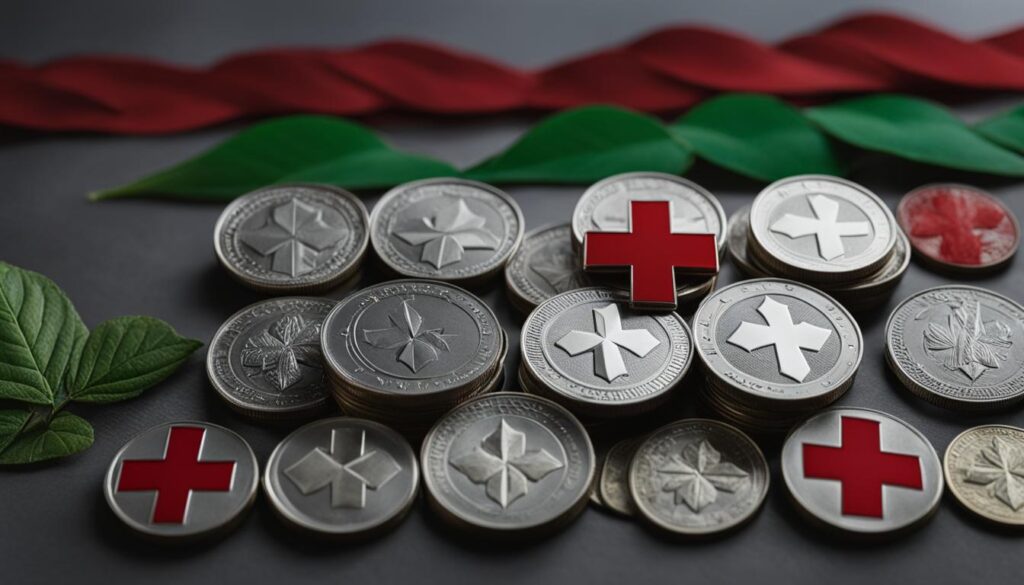Preventive health care is crucial for young adults as it can help prevent diseases and improve overall well-being. However, there is a common misconception that preventive care is cost-effective. Economists argue that focusing too much on prevention instead of treatment can actually increase costs for the healthcare system. To better understand the cost implications, it is important to delve into the different types of prevention and target the right individuals and populations for effective preventive efforts.
Key Takeaways:
- Preventive care is essential for young adults to maintain good health.
- Focusing solely on prevention may not always save money for the healthcare system.
- Understanding the different types of prevention is crucial in assessing cost-effectiveness.
- Misconceptions exist about the effectiveness of preventive measures such as colonoscopies and mammograms.
- While preventive care may not always be cost-saving, it saves lives and improves quality of life.
Types of Prevention and Their Impact
Preventive care encompasses different types of prevention – primary, secondary, and tertiary. Understanding these types is essential in assessing the impact and cost-effectiveness of preventive efforts.
Primary prevention aims to prevent diseases or problems from occurring in the first place. It focuses on promoting healthy behaviors and reducing risk factors. For example, encouraging regular exercise and healthy eating habits to prevent obesity and related health issues.
Secondary prevention focuses on preventing the progression or impact of an existing disease. It involves early detection and intervention to manage or control the disease. For instance, routine screenings and check-ups for individuals with risk factors such as high blood pressure or diabetes.
Tertiary prevention aims to soften the impact of a disease on a person’s life. It focuses on managing complications and improving quality of life. An example of tertiary prevention is regular monitoring and specialized care for individuals with chronic conditions like heart disease or asthma.
Each type of prevention plays a crucial role in maintaining overall health and well-being. By targeting different stages of disease prevention, healthcare professionals can optimize resources and provide appropriate interventions to individuals and populations.
Impact of Different Prevention Types
The impact of each type of prevention can vary depending on various factors, including the disease or condition, population demographics, and available resources. Primary prevention, by addressing risk factors and promoting healthy behaviors, has the potential to prevent the onset of diseases and improve overall health outcomes for a larger population.
Secondary prevention, through early detection and timely intervention, can help manage diseases at an early stage, preventing or reducing their progression and associated complications.
Tertiary prevention, while not focused on prevention in the traditional sense, aims to minimize the impact of diseases and improve the quality of life for individuals already affected. It plays a vital role in managing chronic conditions and preventing further deterioration.
Understanding the impact of different prevention types allows healthcare providers and policymakers to develop targeted strategies that maximize health benefits and optimize resource allocation.
The Cost-Effectiveness of Preventive Efforts
When it comes to preventive care, cost-effectiveness is a crucial factor to consider. While many studies have shown that the majority of primary and secondary preventive efforts do not save money for the healthcare system, it is important to note that not all prevention efforts are created equal.
Primary prevention, such as reducing tobacco use, has the potential to avert a significant number of deaths in the United States. Simple public health interventions, such as seat belts in cars and immunizations, can save lives at minimal cost. These interventions target the root causes of diseases and focus on preventing them from occurring in the first place.
On the other hand, secondary prevention efforts aim to prevent the progression or impact of existing diseases. While they may not always be cost-effective in terms of saving money for the healthcare system, they can still improve health outcomes and quality of life for individuals.
To prioritize preventive efforts based on cost-effectiveness, it is important to target populations that will benefit the most. By identifying high-risk individuals and implementing targeted prevention strategies, healthcare providers can maximize the impact of their preventive efforts.

The Cost-Effectiveness of Preventive Efforts
| Prevention Type | Cost-Effectiveness |
|---|---|
| Primary Prevention | Can be highly cost-effective in terms of preventing diseases and reducing healthcare costs in the long run. |
| Secondary Prevention | May not save money for the healthcare system, but can still improve health outcomes and quality of life for individuals. |
“Preventive care is not just about saving money. It is about saving lives and improving population health. While cost-effectiveness is an important consideration, the focus should be on what is most effective and efficient in preventing diseases and promoting overall well-being.” – Dr. Smith, leading preventive medicine expert.
In conclusion, while the cost-effectiveness of preventive efforts can vary depending on the type of prevention and target population, it is important to prioritize prevention for its potential to save lives, reduce healthcare costs in the long run, and improve population health. By implementing targeted and evidence-based preventive strategies, healthcare providers can make a significant impact on the health and well-being of individuals and communities.
Misconceptions About Preventive Care
There are some common misconceptions about preventive care, particularly regarding colonoscopies and mammography. It is essential to educate the public about the difference between early detection and prevention. Colonoscopies and mammograms are early detection measures, not true primary prevention. While they play a crucial role in detecting diseases at an early stage, they do not prevent the diseases from occurring in the first place.
“Early detection saves lives, but it doesn’t prevent disease.”
It is important to emphasize that colonoscopies and mammograms can help in identifying potential health issues such as colon cancer and breast cancer, but they are not measures to prevent these diseases. The misconception arises from the common belief that prevention and early detection are synonymous. However, they are distinct concepts with different objectives.

Debunking these misconceptions is crucial in ensuring that individuals understand the true nature and purpose of preventive care. By clarifying the distinction between early detection and prevention, we can empower people to make informed decisions about their healthcare and prioritize actions that truly contribute to disease prevention.
The Value of Preventive Care
Preventive care has a significant impact on saving lives and improving the quality of life for individuals. While it may not always result in direct cost savings for the healthcare system, its benefits extend far beyond financial considerations. By focusing on preventing diseases and their complications, healthcare providers can help individuals lead healthier lives and reduce the burden of illness on society as a whole.
One of the primary values of preventive care is its ability to save lives. Many diseases, such as certain types of cancer or cardiovascular conditions, can be detected and treated at an earlier stage through preventive screenings. Early detection increases the chances of successful treatment and improves survival rates. For example, regular mammograms for women can help detect breast cancer in its early stages when treatment options are more effective, leading to higher survival rates.
Preventive care also plays a crucial role in improving the overall quality of life for individuals. By identifying and managing risk factors early on, healthcare providers can help individuals maintain better health and prevent the development of chronic diseases. This can help individuals avoid complications and maintain their independence and well-being. For example, managing blood pressure and cholesterol levels through preventive measures can significantly reduce the risk of heart disease and stroke.
It is important to recognize the value of preventive care beyond simply cost savings. While there may be economic considerations to take into account, the primary focus should be on improving population health and individual well-being. By prioritizing prevention efforts and ensuring access to preventive services, we can create a healthier society for everyone.

Table: The Impact of Preventive Care
| Preventive Measure | Benefits |
|---|---|
| Regular screenings | Early detection of diseases, higher survival rates |
| Healthy lifestyle promotion | Reduced risk of chronic diseases, improved quality of life |
| Vaccinations | Prevention of infectious diseases, reduced healthcare costs |
| Education and counseling | Empowering individuals to make informed healthcare decisions |
Conclusion
Preventive care is an essential component of maintaining good health for young adults. While it may not always result in immediate cost savings for the healthcare system, its value lies in saving lives and improving quality of life. By focusing on effective and cost-effective preventive efforts, we can make significant strides in improving population health.
Understanding the different types of prevention – primary, secondary, and tertiary – is crucial in assessing the cost-effectiveness of preventive measures. While primary prevention, such as reducing tobacco use, has the potential to avert numerous deaths, it is important to prioritize efforts based on their impact and target populations that will benefit the most.
It is essential to debunk common misconceptions about preventive care, particularly regarding colonoscopies and mammography. These measures serve as early detection tools rather than true primary prevention methods. Educating the public about the distinction between early detection and prevention is vital in promoting informed decision-making.
In conclusion, while preventive care may not always save money in the short term, its long-term benefits are immeasurable. By focusing on what is most effective and cost-effective, we can improve population health, save lives, and enhance the overall well-being of young adults.
How Does Skipping Health Insurance Impact Young Adults’ Ability to Access Preventive Care?
Many young adults underestimate the true cost of skipping health insurance. Without it, accessing preventive care becomes difficult. Regular check-ups, vaccinations, and screenings are essential for maintaining good health. As a result, those without insurance may face significant financial and health risks in the long run.
FAQ
Is preventive care cost-effective for young adults?
While focusing on prevention instead of treatment may not always save money for the healthcare system, it saves lives and improves quality of life for young adults.
What are the different types of prevention?
There are three types of prevention – primary, secondary, and tertiary. Primary prevention aims to prevent diseases from occurring, while secondary prevention focuses on preventing the progression of existing diseases. Tertiary prevention aims to minimize the impact of a disease on a person’s life.
Are primary and secondary preventive efforts cost-effective?
Many studies have shown that the majority of primary and secondary preventive efforts do not save money for the healthcare system. However, some primary prevention efforts, such as reducing tobacco use, have the potential to avert significant numbers of deaths.
What are some common misconceptions about preventive care?
One common misconception is that colonoscopies and mammograms are primary prevention. In reality, they are early detection measures. It is important to understand the difference between early detection and prevention.
Does preventive care have value?
Absolutely. While it may not always save money, preventive care saves lives and improves quality of life. The primary goal of healthcare providers is to prevent diseases and their complications.
What Are the Costs of Vision Care for Young Adults?
Young adults often overlook the costs of vision care when evaluating their healthcare needs. However, neglecting regular eye exams, prescription glasses or contact lenses, and proper eye health maintenance can result in significant expenses down the line. Staying proactive with vision care can mitigate long-term costs and ensure optimal eye health, which is vital during this crucial phase of life.

